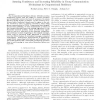221 search results - page 15 / 45 » Computing arbitrary functions of encrypted data |
ATAL
2007
Springer
14 years 1 months ago
2007
Springer
Reinforcement learning promises a generic method for adapting agents to arbitrary tasks in arbitrary stochastic environments, but applying it to new real-world problems remains di...
IFL
1997
Springer
13 years 11 months ago
1997
Springer
Common subexpression elimination is a well-known compiler optimisation that saves time by avoiding the repetition of the same computation. In lazy functional languages, referential...
CORR
2006
Springer
13 years 7 months ago
2006
Springer
Many real world data are sampled functions. As shown by Functional Data Analysis (FDA) methods, spectra, time series, images, gesture recognition data, etc. can be processed more e...
IAW
2003
IEEE
14 years 28 days ago
2003
IEEE
— The Computational Resiliency library (CRLib) provides distributed systems with the ability to sustain operation and dynamically restore the level of assurance in system functio...
NIPS
1998
13 years 9 months ago
1998
A common way to represent a time series is to divide it into shortduration blocks, each of which is then represented by a set of basis functions. A limitation of this approach, ho...

